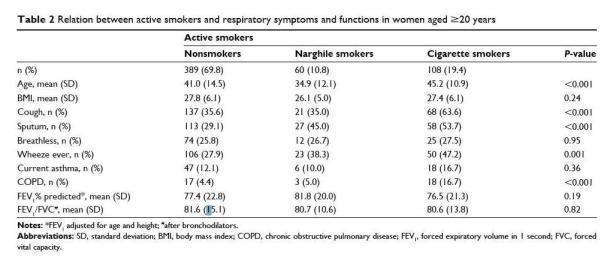In spite of confusion factors, a Syrian independent (this is of utmost importance) study confirms the findings of a previous Tunisian (also independent) one:
 Reference: Mohammad Y, Shaaban R, Abou Al-Zahab B, Khaltaev N, Bousquet J, Dubaybo B. Impact of active and passive smoking as risk factors for asthma and COPD in women presenting to primary care in Syria: first report by the WHO-GARD survey group. International Journal of COPD 2013;8:473-82.
Reference: Mohammad Y, Shaaban R, Abou Al-Zahab B, Khaltaev N, Bousquet J, Dubaybo B. Impact of active and passive smoking as risk factors for asthma and COPD in women presenting to primary care in Syria: first report by the WHO-GARD survey group. International Journal of COPD 2013;8:473-82.
http://www.dovepress.com/articles.php?article_id=14556
Abstract/ Background: The burden of chronic respiratory disease (CRD) is alarming. International studies suggest that women with CRD are undersurveyed and underdiagnosed by physicians worldwide. It is unclear what the prevalence of CRD is in the general population of Syria, particularly among women, since there has never been a survey on CRD in this nation. The purpose of this study was to investigate the impact of different patterns of smoking on CRD in women.
Materials and methods: We extracted data on smoking patterns and outcome in women from the Global Alliance Against Chronic Respiratory Diseases survey. Using spirometric measurements before and after the use of inhaled bronchodilators, we tracked the frequency of CRD in females active and passive narghile or cigarette smokers presenting to primary care. We administered the questionnaire to 788 randomly selected females seen during 1 week in the fiscal year 2009–2010 in 22 primary care centers in six different regions of Syria. Inclusion criteria were age >6 years, presenting for any medical complaint. In this cross-sectional study, three groups of female subjects were evaluated: active smokers of cigarettes, active smokers of narghiles, and passive smokers of either cigarettes or narghiles. These three groups were compared to a control group of female subjects not exposed to active or passive smoking.
Results: Exposure to active cigarette smoke but not narghile smoke was associated with doctor-diagnosed chronic obstructive pulmonary disease (COPD). However, neither cigarette nor narghile active smoking was associated with increased incidence of spirometrically diagnosed COPD. Paradoxically, exposure to passive smoking of either cigarettes or narghiles resulted in association with airway obstruction, defined as forced expiratory volume in 1 second (FEV1)/forced vital capacity (FVC) <70% according to the Global initiative for chronic Obstructive Lung Disease criteria; association with FEV1 < 80% predicted, evidencing moderate to severe GOLD spirometric grade, and doctor-diagnosed COPD. Physicians tend to underdiagnose COPD in women who present to primary care clinics. Whereas around 15% of enrolled women had evidence of COPD with FEV1/FVC < 70% after bronchodilators, only 4.8% were physician-diagnosed. Asthma did not appear to be a significant spirometric finding in these female subjects, although around 11% had physician-diagnosed asthma. One limitation is FEV1/FVC < 70% could have also resulted from uncontrolled asthma. The same limitation has been reported by the Proyecto Latinoamericano de Investigacion en Obstruccion Pulmonar (PLATINO) study.
Conclusion: Contrary to popular belief in developing countries, women exposed to tobacco smoke, whether active or passive, and whether by cigarettes or narghiles, like men are at increased risk for the development of COPD, although cultural habits and taboos may decrease the risk of active smoking in some women.
Recommendations: These findings will be considered for country and region strategy for noncommunicable diseases, to overcome underdiagnosis of CRD in women, fight widespread female cigarette and narghile smoking, and promote behavioral research in this field.
Our comment:
The authors’ conclusions and recommendations do not take into account the confusion factors (cigarette narghile smokes intermixed in many instances). Cigarette and narghile environmental tobacco smokes are (chemically, to start with) completely different from each other. See: Hookah (Shisha, Narghile) Smoking and Environmental Tobacco Smoke (ETS). A Critical Review of the Relevant Literature and the Public Health Consequences. Int. J. Environ. Res. Public Health 2009; 6(2):798-843.
http://www.pubmedcentral.nih.gov/articlerender.fcgi?tool=pubmed&pubmedid=19440416
See similar study: “Tunisian Revolutionary Doctors Find Middle East Peace Pipe Much Less Detrimental to Lungs than Cigarettes”, 11 Feb 2014

Leave a comment